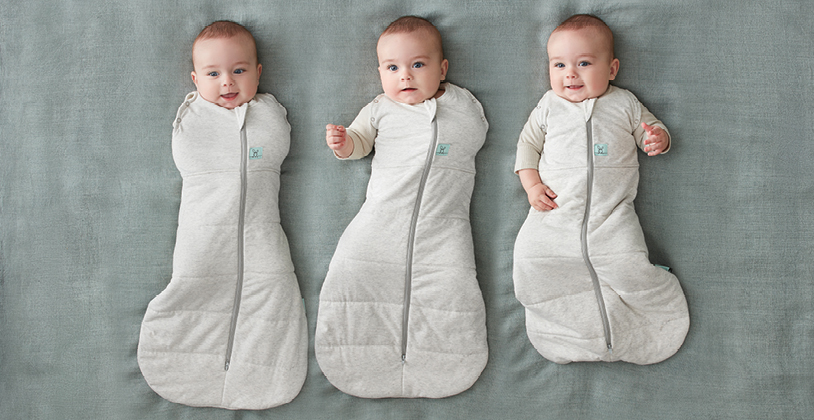When to stop swaddling your baby
Congratulations! You’ve survived the first few months of a newborn, have them wrapped snuggly in a swaddle, and baby has finally settled into a predictable sleep routine. And then comes baby’s first major milestone, rolling, to undo all that hard work!
Many parents are apprehensive to unswaddle their baby once they reach the rolling milestone, for fear of what it will do for settling and sleep. What those parents may not know is that once a baby shows signs of rolling it is no longer safe to swaddle them, and the transition to arms-out sleeping must begin.
Why is it unsafe to swaddle a baby who is attempting to roll?
A baby who is ready to roll is transitioning out of the ‘fencing reflex’, an innate newborn mechanism designed to keep the body anchored on their back and prevent SIDS. Once this reflex starts to disappear, your baby would have built the necessary strength and muscle tone to hold their head up and roll their body over. A baby that is learning to roll from back-to-front needs their arms free to help roll back, and/or lift their neck and head sideways for clear and unobstructed breathing whilst face down.
What are the signs of attempting to roll?
Indicators that your baby is showing signs of rolling, and no longer requires a swaddle for sleeping include:
- Attempting to roll body when unswaddled
- Pushing up on hands during tummy time, lifting one hand off the ground
- Fussiness when swaddled/fighting the swaddle when going on
- Disrupted sleep
- Disappearance of the startle (moro) reflex
- Attempting to have hands free/up around their face when the swaddle is on
At what age will this happen?
While there is no set rule for the exact time to move through the transition from swaddle to arms-out sleeping, it typically starts between 3-6 months old. However, some babies may start earlier, some may take longer. You may be unsure of when exactly to make the transition, however you know your baby best. Follow the signs above and your baby’s cues as the best way to get through this stage.
Between 4-6 months babies outgrow the startle (moro) reflex. If your baby is not yet rolling and still swaddled, but is no longer startling this may also indicate it is time to transition from swaddling.
How to safely transition your baby to arms-out sleeping in a sleeping bagSome babies may struggle with this change in their sleeping environment. As such we recommend a two-step approach to transitioning:
Step One: Releasing one arm out of your baby's swaddle for all sleeps, to allow your baby time to become used to this new way of sleeping.
Step Two: After a week or so of one-arm-out sleeping, remove both arms from the swaddle. Expect some difficult sleeps during this phase, but stick with it and don’t be tempted to re-swaddle them – they will adjust to the new sleep position.
Once your baby is rolling on their own, if they independently roll on to their tummy in their sleep with their arms out of a swaddle, you do not need to roll them back.

What should baby wear once unswaddled?
Your baby should be sleeping in a sleeping bag appropriate for the room temperature of the nursery, with no blankets, pillows or other sleep aids in the cot. For babies that are coming out of the ergoPouch Cocoon Swaddle Bag, parents need to simply open the press stud poppers in the armholes to convert this baby swaddle into your baby’s first sleeping bag when they start to show signs of rolling.
For babies that are coming out of another type of swaddle, the size 3-6 or 6-12 month Cocoon Swaddle Bag is still the best option as a first sleeping bag for them, being TOG-rated for warmth, snug fitting around the body for security, age-appropriate, and bell-shaped for hip health.
Use ergoPouch's What to Wear Guide to help you choose what to layer underneath your baby’s sleeping bag, and to choose which TOGs to put together based on the room temperature.

